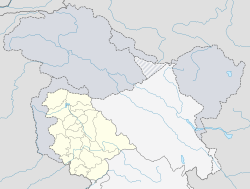Jammu Division
|
Jammu Division جموں जम्मू ਜੱਮੂ |
|
|---|---|
| Administrative Division | |

View of Jammu city and the Tawi River
|
|
 Jammu (orange bordered) lies in Indian state Jammu & Kashmir |
|
| Location of Jammu city in the Jammu Division | |
| Coordinates: 32°44′N 74°52′E / 32.73°N 74.87°ECoordinates: 32°44′N 74°52′E / 32.73°N 74.87°E | |
| Country | India |
| State | Jammu and Kashmir |
| District | Jammu, Doda, Kathua, Ramban, Reasi, Kishtwar, Poonch, Rajouri, Udhampur, Samba |
| Founded | 14th century BC |
| Founded by | Raja Jambu Lochan |
| Headquarters | Jammu |
| Government | |
| • Type | Central |
| • Body | State gov |
| Area | |
| • Total | 26,293 km2 (10,152 sq mi) |
| Elevation | 305 m (1,001 ft) |
| Population | |
| • Total | 5,350,811 |
| • Density | 200/km2 (530/sq mi) |
| Languages | |
| • Official Urdu |
Secondary official English, Dogri, Punjabi |
| Time zone | IST (UTC+5:30) |
Secondary official
Jammu /ˈdʒɑːmuː/ is one of the three administrative divisions within Jammu and Kashmir, the northernmost state in India. It consists of the districts of Jammu, Doda, Kathua, Ramban, Reasi, Kishtwar, Poonch, Rajouri, Udhampur and Samba. Most of the land is hilly or mountainous, including the Pir Panjal Range which separates it from the Kashmir Valley and part of the Great Himalayas in the eastern districts of Doda and Kishtwar. Its principal river is the Chenab. Chenab Valley is another important division in Jammu region.
Jammu city is the largest city in Jammu and the winter capital of Jammu and Kashmir. It is also known as "City of Temples" as it has many temples and shrines, with glittering shikhars soaring into the sky, which dot the city’s skyline, creating the ambiance of a holy and peaceful Hindu city.
Home to some of India's most popular Hindu shrines, such as Vaishno Devi, Jammu is a major pilgrimage centre for Hindus. A majority of Jammu's population practices Hinduism, while Islam and Sikhism enjoy a strong cultural heritage in the region. Due to relatively better infrastructure, Jammu has emerged as the main economic center of the state.
...
Wikipedia


